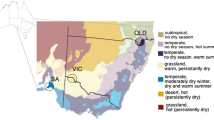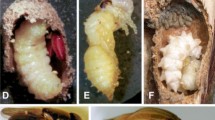Abstract
Tropical habitats are characterized by strong wet and dry seasons, but the effects of seasonality on the costs and benefit of sociality are largely unknown for tropical insects. This is an important gap in our understanding of sociobiology because many social bees and wasps are in the tropics. We found evidence of seasonal effects on the costs and benefits of social and solitary behavior in the tropical sweat bee Megalopta genalis. Productivity, whether measured as brood cell production per nest, or brood cell production per female, was greater in the dry season than the wet, likely reflecting floral resource availability. Per nest productivity was greater in social nests than solitary, but this difference was only significant in the dry season. Conversely, per capita productivity was greater in solitary than social nests, but again only in the dry season. Nest failure rates were also higher in the wet season, although roofs protecting nests from rain did not increase survival, suggesting that increased foraging effort in the face of declining resources rather than wetness per se led to nest failure. Newly initiated nests had higher failure rates than established nests, but these were not affected by season. Social nests collected late in the wet season after reproduction has largely ceased show that M. genalis can live in social groups without reproduction; these bees are likely waiting together until provisioning resumes in the subsequent dry season. Our results suggest that the productivity benefits of social nesting are greatest in the dry season, but that insurance-based benefits to social nesting may be greater in the wet season. This reveals that the costs and benefits underpinning sociality are dynamic across seasons, even in tropical systems.







Similar content being viewed by others
References
Brand N, Chapuisat M (2014) Impact of helpers on colony productivity in a primitively eusocial bee. Behav Ecol Sociobiol 68:291–298
Clouse R (2001) Some effects of group size on the output of beginning nests of Mischocyttarus mexicanus (Hymenoptera: Vespidae). Fla Entomol 84:418–425
Davison P, Field J (2016) Social polymorphism in the sweat bee Lasioglossum (Evylaeus) calceatum. Insectes Soc 63:327–338
Davison P, Field J (2018) Environmental barriers to sociality in an obligate eusocial sweat bee. Insectes Soc 65:549–559
Eickwort GC, Eickwort KR (1971) Aspects of the biology of Costa Rican halictine bees, II. Dialictus umbripennis and adaptations of its caste structure to different climates. J Kans Entomol Soc 44:343–373
Eickwort GC, Eickwort JM, Gordon J, Eickwort MA, Wcislo W (1996) Solitary behavior in a high-altitude population of the social sweat bee Halictus rubicundus (Hymenoptera: Halictidae). Behav Ecol Sociobiol 38:227–233
Field J, Paxton RJ, Soro A, Bridge C (2010) Cryptic plasticity underlies a major evolutionary transition. Curr Biol 20:2028–2031
Field J, Paxton R, Soro A, Craze P, Bridge C (2012) Body size, demography and foraging in a socially plastic sweat bee: a common garden experiment. Behav Ecol Sociobiol 66:743–756
Gadagkar R (1990) Evolution of eusociality: the advantage of assured fitness returns. Philos Trans R Soc Lond Ser B Biol Sci 329:17–25
Hamilton WD (1964) The genetical evolution of social behaviour. II. J Theor Biol 7:17–52
Hatchwell BJ, Komdeur J (2000) Ecological constraints, life history traits and the evolution of cooperative breeding. Anim Behav 59:1079–1086
Hogendoorn K, Zammit J (2001) Benefits of cooperative breeding through increased colony survival in an allodapine bee. Insectes Soc 48:392–397
Kapheim KM, Smith AR, Nonacs P, Wcislo WT, Wayne RK (2013) Foundress polyphenism and the origins of eusociality in a facultatively eusocial sweat bee, Megalopta genalis (Halictidae). Behav Ecol Sociobiol 67:331–340
Kapheim KM, Nonacs P, Smith AR, Wayne RK, Wcislo WT (2015) Kinship, parental manipulation and evolutionary origins of eusociality. Proc Biol Sci 282:20142886. https://doi.org/10.1098/rspb.2014.2886
Kocher SD, Paxton RJ (2014) Comparative methods offer powerful insights into social evolution in bees. Apidologie 45:289–305
Kocher SD, Pellissier L, Veller C, Purcell J, Nowak MA, Chapuisat M, Pierce NE (2014) Transitions in social complexity along elevational gradients reveal a combined impact of season length and development time on social evolution. Proc Biol Sci 1:1. https://doi.org/10.1098/rspb.2014.0627
Korb J, Heinze J (2008) Ecology of social evolution. Springer, Berlin
Kukuk PF, Ward SA, Jozwiak A (1998) Mutualistic benefits generate an unequal distribution of risky activities among unrelated group members. Naturwissenschaften 85:445–449
Leigh EG (1999) Tropical forest ecology: a view from Barro Colorado Island. Oxford University Press, Oxford
Lin N, Michener CD (1972) Evolution of sociality in insects. Q Rev Biol 47:131–159
Michener CD, Lange RB (1958a) Observations on the behavior of Brasilian halictid bees V. Chloralictus. Insectes Soc 5:379–407
Michener CD, Lange RB (1958b) Observations on the behavior of Brasilian halictid bees (Hymenoptera, Apoidea) III. Univ Kansas Sci Bull 34:473–505
Michener CD, Lange RB (1959) Observations on the behavior of Brazilian halictid bees (Hymenoptera, Apoidea). IV, Augochloropsis, with notes on extralimital forms. Am Mus Novit 1924:1–41
Michener CD, Seabra CAC (1959) Observations on the behavior of Brasilian halictid bees, VI, tropical species. J Kans Entomol Soc 32:19–28
Michener CD, Wille A (1961) The bionomics of a primitively social bee, Lasioglossum inconspicuum. Univ Kansas Sci Bull 42:1123–1202
Mueller UG (1996) Life history and social evolution of the primitively eusocial bee Augochlorella striata (Hymenoptera: Halictidae). J Kans Entomol Soc 69:116–138
Packer L (1986) Multiple-foundress associations in a temperate population of Halictus ligatus (Hymenoptera; Halictidae). Can J Zool 64:2325–2332
Packer L (1993) Multiple foundress associations in sweat bees (Hymenoptera: Halictidae). In: Keller L (ed) Queen number and sociality in insects. Oxford University Press, Oxford, pp 215–233
Packer L, Jessome V, Lockerbie C, Sampson B (1989) The phenology and social biology of four sweat bees in a marginal environment: Cape Breton Island. Can J Zool 67:2871–2877
Purcell J (2011) Geographic patterns in the distribution of social systems in terrestrial arthropods. Biol Rev Camb Philos Soc 86:475–491
Queller DC (1989) The evolution of eusociality: reproductive head starts of workers. Proc Natl Acad Sci USA 86:3224–3226. https://doi.org/10.1073/pnas.86.9.3224
Queller DC (1994) Extended parental care and the origin of eusociality. Proc R Soc Lond Ser B Biol Sci 256:105–111
Richards MH (2004) Annual and social variation in foraging effort of the obligately eusocial sweat bee, Halictus ligatus (Hymenoptera: Halictidae). J Kans Entomol Soc 77:484–503
Richards MH, Packer L (1995) Annual variation in survival and reproduction of the primitively eusocial sweat bee Halictus ligatus (Hymenoptera: Halictidae). Can J Zool 73:933–941
Richards MH, French D, Paxton RJ (2005) It’s good to be queen: classically eusocial colony structure and low worker fitness in an obligately social sweat bee. Mol Ecol 14:4123–4133
Richards MH, Onuferko TM, Rehan SM (2015) Phenological, but not social, variation associated with climate differences in a eusocial sweat bee, Halictus ligatus, nesting in southern Ontario. J Hymenopt Res 43:19–44
Roubik DW, Wolda H (2001) Do competing honey bees matter? Dynamics and abundance of native bees before and after honey bee invasion. Popul Ecol 43:53–62
Sakagami SF (1977) Seasonal change of nest survival and related aspects in an aggregation of Lasioglossum duplex (Dalla Torre), a eusocial halictine bee (Hymenoptera: Halictidae). Res Popul Ecol 19:69–86
Sakagami SF, Fukuda H (1989) Nest founding and nest survival in a eusocial halictine bee, Lasioglossum duplex: additional observations. Res Popul Ecol 31:139–151
Sakagami SF, Hayashida K (1968) Bionomics and sociology of the summer matrifilial phase in the social halictine bee, Lasioglossum duplex. J Fac Sci Hokkaido Univ Ser 6 Zool 16:413–513
Sakagami SF, Munakata M (1972) Distribution and bionomics of a transpalaearctic eusocial halictine bee, Lasioglossum (Evylaeus) calceatum, in northern Japan, with reference to its solitary life cycle at high altitude. J Fac Sci Hokkaido Univ Ser 6 Zool 18:411–439
Schwarz M, Bull N, Hogendoorn K (1998) Evolution of sociality in the allodapine bees: a review of sex allocation, ecology and evolution. Insectes Soc 45:349–368
Schwarz MP, Richards MH, Danforth BN (2007) Changing paradigms in insect social evolution: insights from halictine and allodapine bees. Annu Rev Entomol 52:127–150
Smith AR, Wcislo WT, O’Donnell S (2003) Assured fitness returns favor sociality in a mass-provisioning sweat bee, Megalopta genalis (Hymenoptera: Halictidae). Behav Ecol Sociobiol 54:14–21
Smith AR, Wcislo WT, O’Donnell S (2007) Survival and productivity benefits to social nesting in the sweat bee Megalopta genalis (Hymenoptera: Halictidae). Behav Ecol Sociobiol 61:1111–1120
Smith AR, Wcislo WT, O’Donnell S (2008) Body size shapes caste expression, and cleptoparasitism reduces body size in the facultatively eusocial bees Megalopta (Hymenoptera: Halictidae). J Insect Behav 21:394–406
Smith AR, Kapheim KM, O’Donnell S, Wcislo WT (2009) Social competition but not subfertility leads to a division of labour in the facultatively social sweat bee Megalopta genalis (Hymenoptera: Halictidae). Anim Behav 78:1043–1050
Smith AR, Lopez Quintero IJ, Moreno Patino JE, Roubik DW, Wcislo WT (2012) Pollen use by Megalopta sweat bees in relation to resource availability in a tropical forest. Ecol Entomol 37:309–317
Smith A, Harper C, Kapheim K, Simons M, Kingwell C, Wcislo W (2018) Effects of social organization and resource availability on brood parasitism in the facultatively social nocturnal bee Megalopta genalis. Insectes Soc 65:85–93
Smith A, Kapheim K, Kingwell C, Wcislo W (2019) A split sex ratio in solitary and social nests of a facultatively social bee. Biol Lett 15:20180740
Staab M, Pufal G, Tscharntke T, Klein A (2018) Trap nests for bees and wasps to analyse trophic interactions in changing environments—A systematic overview and user guide. Methods Ecol Evolut 9:2226–2239
Strohm E, Bordon-Hauser A (2003) Advantages and disadvantages of large colony size in a halictid bee: the queen’s perspective. Behav Ecol 14:546–553
Tierney SM, Fischer CN, Rehan S, Kapheim KM, Wcislo WT (2013) Frequency of social nesting in the sweat bee Megalopta genalis (Halictidae) does not vary across a rainfall gradient, despite disparity in brood production and body size. Insectes Soc 60:163–172
Wcislo WT (1997) Behavioral environments of sweat bees (Halictinae) in relation to variability in social organization. In: Choe JC, Crespi BJ (eds) The evolution of social behavior in insects and arachnids. Cambridge University Press, Cambridge, pp 316–332
Wcislo W, Gonzalez V (2006) Social and ecological contexts of trophallaxis in facultatively social sweat bees, Megalopta genalis and M. ecuadoria (Hymenoptera, Halictidae). Insectes Soc 53:220–225
Wcislo WT, Wille A, Orozco E (1993) Nesting biology of tropical solitary and social sweat bees, Lasioglossum (Dialictus) figueresi Wcislo and L. (D.) aeneiventre (Friese)(Hymenoptera: Halictidae). Insectes Soc 40:21–40
Wcislo WT, Arneson L, Roesch K, Gonzalez V, Smith A, Fernández H (2004) The evolution of nocturnal behaviour in sweat bees, Megalopta genalis and M. ecuadoria (Hymenoptera: Halictidae): an escape from competitors and enemies? Biol J Linn Soc 83:377–387
Wille A, Orozco E (1970) The life cycle and behavior of the social bee Lasioglossum (Dialictus) umbripenne (Hymenoptera: Halictidae). Rev Biol Trop 17:199–245
Wolda H (1988) Insect seasonality: why? Annu Rev Ecol Syst 19:1–18
Wolda H, Roubik DW (1986) Nocturnal bee abundance and seasonal bee activity in a Panamanian forest. Ecology 67:426–433
Wright SJ, Calderon O (1995) Phylogenetic patterns among tropical flowering phenologies. J Ecol 83:937–948
Yagi N, Hasegawa E (2011) Both cooperation and nest position improve larval survival in the sweat bee, Lasioglossum (Evylaeus) baleicum. J Ethol 29:63–67
Zammit J, Hogendoorn K, Schwarz M (2008) Strong constraints to independent nesting in a facultatively social bee: quantifying the effects of enemies-at-the-nest. Insectes Soc 55:74–78
Acknowledgements
We thank the staff of BCI field station and numerous field assistants for enabling our research. Callum Kingwell’s comments improved an early draft of the manuscript. The authors are supported by NSF Grant #17-1028536545. WW was supported by general research funds from STRI.
Author information
Authors and Affiliations
Corresponding author
Electronic supplementary material
Below is the link to the electronic supplementary material.
Rights and permissions
About this article
Cite this article
Smith, A.R., Kapheim, K.M. & Wcislo, W.T. Survival and productivity benefits of sociality vary seasonally in the tropical, facultatively eusocial bee Megalopta genalis. Insect. Soc. 66, 555–568 (2019). https://doi.org/10.1007/s00040-019-00713-z
Received:
Revised:
Accepted:
Published:
Issue Date:
DOI: https://doi.org/10.1007/s00040-019-00713-z




